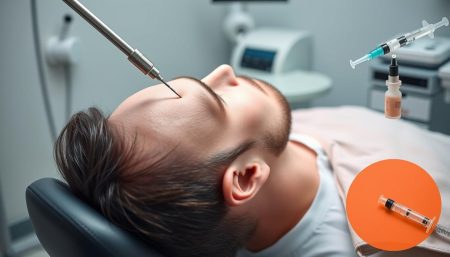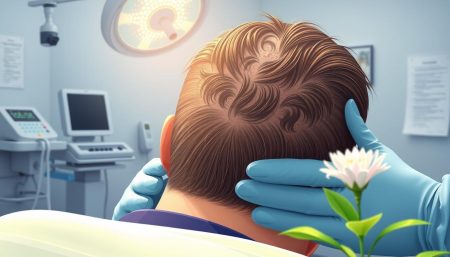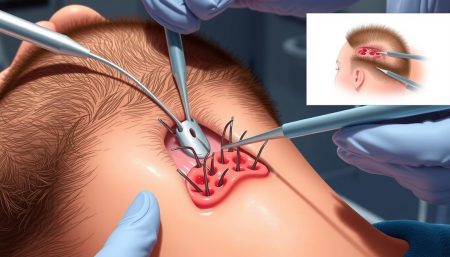Many people look for a lasting solution to hair loss. They want results that truly last. That’s where permanent hair restoration comes in. It’s a field that’s growing fast, offering hope to those who are losing their hair.
Hair transplants are no longer a secret. They’re now a popular hair loss treatment. But the big question is: Do these results really last? Let’s dive into the world of transplanted hair growth and find out.
Key Takeaways
- Understanding the permanency of hair transplant procedures.
- Exploring the effectiveness of hair transplants as a long-term hair loss treatment.
- Insights into the growth cycle and longevity of transplanted hair.
- The importance of realistic expectations surrounding permanent hair restoration.
- Previewing factors that contribute to the success of hair transplant results.
Understanding Hair Transplant Techniques
The world of surgical hair restoration has changed a lot over the years. Now, we have follicular unit extraction (FUE) and follicular unit transplantation (FUT). These methods have made hair transplants look and last longer. They work differently, affecting how quickly you recover and how long the results last.
Follicular Unit Extraction (FUE)
FUE is a gentler surgical hair restoration method. It uses small punches to take out hair follicles one by one from your scalp. This way, it leaves little to no scars and you heal faster. The follicles are then moved to thin or bald spots, making your hair look natural again.
Follicular Unit Transplantation (FUT)
FUT is different because it takes a strip of skin from the back of your head. This strip is then cut into smaller units under a microscope. These units are then moved to where you need more hair. Even though it takes longer to heal, it’s great for covering big areas.
Both FUE and FUT are key in follicular unit transplantation and extraction. They help people regain their hair and confidence.
| Technique | Description | Recovery Time | Scarring |
|---|---|---|---|
| FUE | Individual follicles extracted directly | Shorter | Minimal |
| FUT | Strip of tissue removed and dissected | Longer | Noticeable |
Is Hair Transplant Permanent?
When thinking about permanent hair restoration, many wonder if hair transplants last forever. For some, knowing if transplanted hair growth stays for good is key. It helps decide if this method fits their long-term beauty plans.
The secret to understanding hair transplant permanence is in the process itself. Follicles from the back of the head, where hair doesn’t fall out, are moved to thinning spots. These new follicles keep their resistance to balding. This is why the results can last a long time.

But, how long permanent hair restoration lasts depends on many things. These include your health, the surgeon’s skill, and how well you care for your hair after. Even though the transplanted hair growth usually stays, you might need ongoing care and treatments. This helps keep your hair healthy and dense.
Getting a detailed analysis and advice from experts is very important. Talking to skilled surgeons and dermatologists can show how well the transplant will work for you. They can tailor the treatment to fit your specific needs.
In the end, while hair transplants aim to be a lasting fix, calling them completely ‘permanent’ is not always right. It’s important to remember the need for ongoing care and the role of genetics.
The Life Cycle of Transplanted Hair
Knowing how transplanted hair grows is key to understanding what to expect after surgery. The journey from shedding to regrowth is different for everyone.
Immediate Post-Transplant Phase
Right after surgery, patients often see a lot of shedding. This is a normal part of healing. The new hair falls out in the first few weeks. It’s a sign that the new hair is getting ready to grow.
Long-Term Hair Growth
After shedding, the roots start to heal. By the third month, new hair growth is visible. By 6-12 months, the hair transplant results are clear. Patients see a big increase in hair density and coverage.
It’s important to remember that the initial shedding is just a temporary step. With patience and proper scalp care, the results can be amazing.
Factors Affecting Hair Transplant Longevity
The success of permanent hair restoration like hair transplants is quite high. But, many things can affect how well they work. The quality of donor hair grafts and the skill of the surgical team are key.
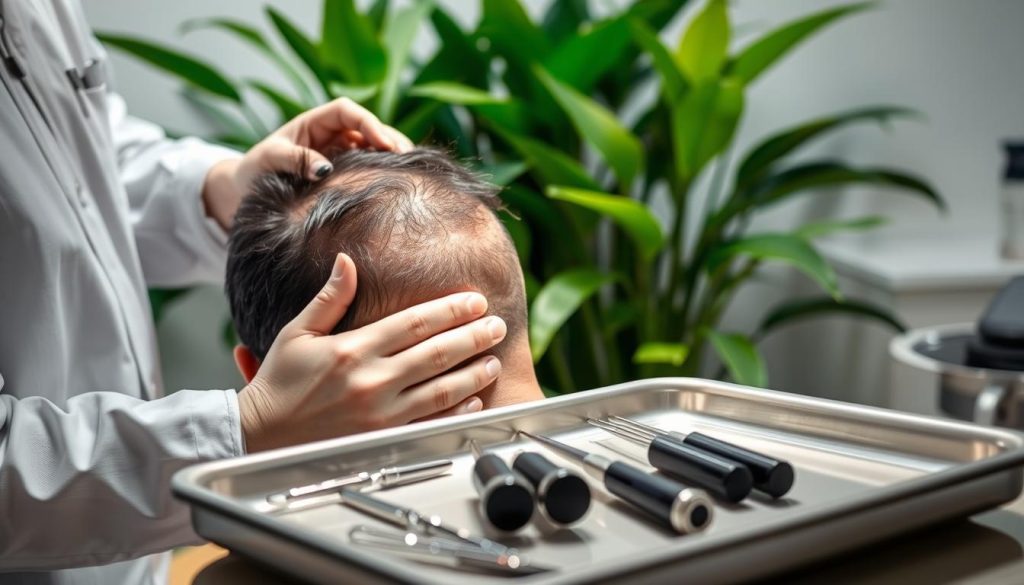
Quality of Donor Hair
The success of a hair transplant depends a lot on the donor hair quality. Good donor hair grows well, looks natural, and lasts long. It’s usually taken from the back or sides of the scalp, where hair loss is less common.
This choice helps the transplanted hair grow better. It makes the transplant look fuller and more natural.
Expertise of the Surgical Team
The skill of the surgical team is also very important for permanent hair restoration. They need to be very good at transplanting donor hair grafts. This ensures the hair grows well and looks good.
Their experience also helps the healing process. With their care, the transplant looks better and there are fewer problems.
Comparing Permanent Hair Restoration Options
When looking into permanent hair restoration, it’s key to compare the options. This helps figure out which might give the best hair transplant results in the long run. There are many surgical and non-surgical methods, each with its own pros and cons.
- Surgical Hair Transplants: These methods, like FUE and FUT, are known for their success. They help achieve a natural and dense look.
- Non-Surgical Methods: Options like minoxidil, laser therapy, and PRP therapy are less invasive. However, they need ongoing use to keep the results.
It’s important to know the details of each method to pick the best for your hair restoration. Here’s a comparison:
| Treatment Type | Method | Duration of Effectiveness | Considerations |
|---|---|---|---|
| FUE | Surgical | Permanent | High initial cost, longer recovery |
| FUT | Surgical | Permanent | Scarring potential, dense results |
| Minoxidil | Topical | Continuous use | Must be applied daily, variable results |
| Laser Therapy | Non-surgical | As long as treatment continues | Non-invasive, multiple sessions required |
| PRP Therapy | Non-surgical | 1-2 years | Multiple treatments, maintenance treatments |
Evaluating permanent hair restoration options means looking at how long the hair transplant results last and the commitment needed for upkeep. The best results often come from choosing the right method and possibly combining different techniques based on individual needs.
What to Expect Immediately After Surgery
Getting a hair transplant is a big step towards getting your hair and confidence back. But, you need to know about the first few weeks after surgery. This time is key to making sure the transplant works well.
Post-Transplant Shedding
Shedding after a hair transplant is normal. It starts a few weeks after the surgery. It might look scary, but it’s a sign that the new hair follicles are getting ready to grow.
Caring for Your Scalp
Keeping your scalp healthy after surgery is very important. You need to be gentle and follow your doctor’s advice. Here are some tips:
- Avoid harsh chemicals or shampoos in the initial weeks.
- Do not scratch or rub the transplanted area.
- Keep the scalp clean and hydrated according to doctor’s recommendations.
Here’s a table to help you manage shedding and get the best results from your transplant:
| Timeframe | Activity | Notes |
|---|---|---|
| Day 1-7 | Rest and avoid strenuous activity | Helps reduce swelling and protects grafts |
| Week 2-4 | Begin gentle washing with prescribed products | Prevents scabbing and aids healing |
| Month 1-3 | Monitor for signs of post-transplant shedding | Normal part of recovery process |
| Month 4+ | Regular check-ups and follow care regimen | Ensure healthy growth of new hair |
Following these tips will help you get the best results from your transplant. Remember, being patient and taking good care of your scalp is key during this time.
Realistic Expectations: Hair Transplant Results
Knowing what to expect after a hair transplant is key for happiness and mental readiness. We’ll share common timelines and experiences to help set realistic hopes for transplanted hair growth.
At first, you might see “shock loss,” where the transplanted hair looks thinner. But, this is just the start of new hair growth. Let’s dive into the expected times for hair transplant results.
Initial Hair Growth
Right after the surgery, the transplanted hair will likely fall out. But, new hair will start growing in about three to four months. At first, the growth might not look even, but it will get better over time.
Final Results Timeline
The real results of the transplant will show up around 12 to 18 months later. By then, you’ll see a fuller and more natural-looking hairline.
To understand more about these growth stages and the science behind them, check out this guide on hair transplant sustainability.
| Time Post-Transplant | Expected Growth Stage |
|---|---|
| 0-3 Months | Most hair sheds, dormant stage |
| 3-4 Months | Initial signs of new hair growth |
| 5-8 Months | Noticeable growth, still might be patchy |
| 12-18 Months | Full, mature transplanted hair growth, final results observed |
Common Misconceptions About Hair Transplants
When thinking about permanent hair restoration, it’s key to clear up some common myths. These myths might shape your expectations.
Many believe hair transplant results show up right away. But, it can take months to see the full effects. At first, the transplanted hair might fall out, a process called shedding. Then, it grows back for good.
Some think hair transplants are only for the top of the head. But, they can be done in thinning areas like the eyebrows and beard too.
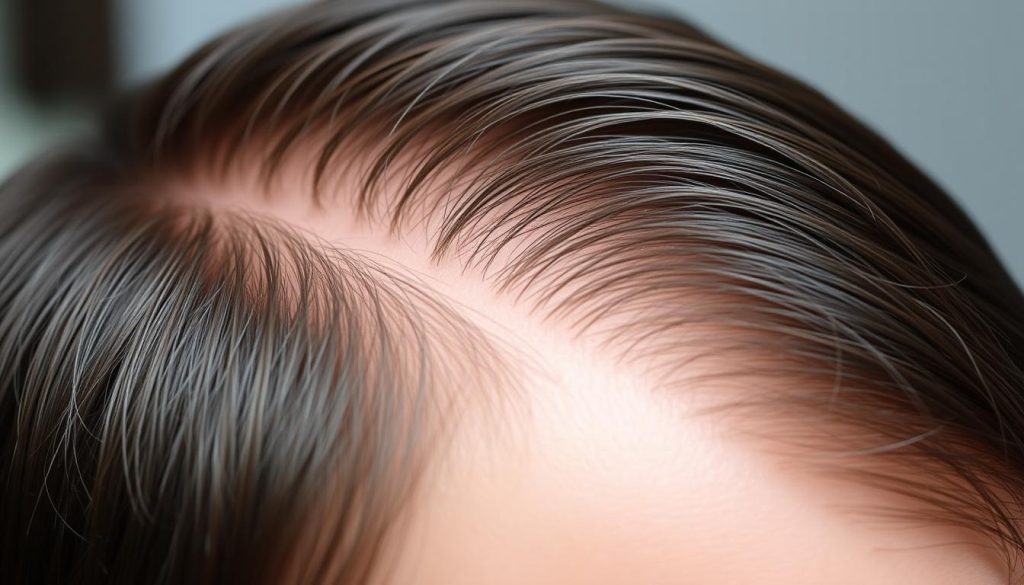
Another myth is that permanent hair restoration makes hair look too thick. But, today’s methods aim for a natural look that fits in with the rest of your hair.
There’s a belief that donor hair must come from someone else. But, donor hair actually comes from the patient’s own scalp. This ensures it grows naturally.
To clear up more misconceptions, here are some facts:
- Scarring is obvious: New methods have made scarring much less noticeable.
- Results are temporary: A well-done hair transplant can last a lifetime, offering lasting results.
- It’s an extremely painful process: Thanks to new tech, hair transplants are now less painful and less invasive.
Knowing these facts helps set realistic hopes. It also boosts your satisfaction with your hair transplant results.
| Misconception | Reality |
|---|---|
| Hair transplant is only for men | Both men and women can benefit from hair transplants. |
| Transplants look artificial | Techniques aim for a natural appearance that blends with existing hair. |
| It solves all hair loss issues | Transplants are best for certain types of hair loss, not all. |
If you’re thinking about permanent hair restoration, talk to certified pros. They can give you tailored advice based on your hair loss and health.
Post-Operative Care for Lasting Results
Getting the most out of hair transplant results depends on post-surgery care. Taking good care of your hair grafts after surgery is key. It helps keep your hair looking great.
Medication and Treatments
After a hair transplant, doctors might give you medicines to help you heal and grow hair. You might get antibiotics to fight off infections. Anti-inflammatory drugs can also help reduce swelling.
In some cases, you might be given products to help your hair grow. These can include minoxidil or finasteride. They help both your existing and transplanted hair grow better.
Lifestyle and Hair Care
Changing your lifestyle and hair care routine is important after surgery. Use gentle shampoos and avoid harsh chemicals. Also, protect your scalp from too much sun.
Eating well and managing stress can also help your hair. A healthy diet and less stress can make your hair healthier.
| Aspect of Care | Recommendations | Benefits |
|---|---|---|
| Medication | Antibiotics, Anti-inflammatory, Hair growth enhancers | Prevents infections, reduces swelling, supports hair growth |
| Lifestyle Changes | Nutritious diet, Stress management | Improves overall health of hair |
| Hair Care | Gentle washing, Avoid harsh chemicals, UV protection | Protects donor grafts, optimizes transplant results |
How to Choose the Right Hair Loss Treatment
Finding the right hair loss treatment can be tough. There are many options, from easy-to-find solutions to more serious permanent treatments. It’s key to know what you need and what works best.
Assessing Your Hair Loss
First, you need to figure out the type and how much hair you’ve lost. A detailed check can tell if it’s a short-term problem or a long-term issue. This helps you and your doctor pick the best treatment, which might use more than one method.
Consulting with Hair Restoration Experts
Getting advice from hair restoration pros is super helpful. They give advice based on your hair loss and what you hope to achieve. They consider your age, hair type, and health to suggest the best treatments.
It’s smart to talk to several experts. This way, you can see different views and plans. It helps you understand what modern treatments can do for you.

Experts can explain the differences between treatments, like surgery or non-invasive methods. They’ll share the good and bad of each, including how long it takes to see results and how to keep it up.
The best treatment fits your goals, lifestyle, and budget. Knowing what to expect makes sticking to a treatment plan easier. Trusted experts help set clear goals and milestones for you.
Success Stories: Before and After Comparisons
Hair transplant procedures can change lives. Here, we share real success stories. They show the amazing results through before and after photos.
These comparisons show how hair transplants can change how you look. They also help people understand what to expect from their own procedures. Remember, results can vary, but technology keeps getting better.
- Increased confidence: Many people feel more confident after getting a hair transplant.
- Natural-looking results: New techniques make the transplanted hair look like your own, blending in perfectly.
- Durability: With the right care, hair transplant results can last forever, improving your life greatly.
Seeing these before and after photos can help you decide if a hair transplant is right for you. They show the skill of surgeons and the courage of those who choose this path.
Risks and Considerations in Surgical Hair Restoration
Surgical hair restoration is known for improving hair transplant results. But, it’s key for those thinking about it to know the risks and what’s needed for success. Knowing this helps set the right expectations and get ready for the surgery.
Potential Complications
Even though hair transplant surgeries work well, problems can happen. These might include infections, scarring, and hair that looks unnatural. Choosing a skilled surgeon can lower these risks. It’s important to talk about possible side effects with your doctor before starting.
Ensuring a Successful Recovery
The recovery time is crucial for getting the best hair transplant results. Following your surgeon’s post-op care tips can help you heal faster and grow hair better. Stay away from hard work and direct sunlight, and be gentle with your hair.
For more on making your text easy to read, check out this guide on typographic and content structuring techniques.

| Complication | Prevention Measure | Impact on Results |
|---|---|---|
| Infection | Maintain cleanliness, use prescribed antibiotics | Can hinder follicle health if not managed |
| Scarring | Choose experienced surgeon, follow care instructions | Minimal visual impact with proper care |
| Unnatural Look | Discuss expectations, review before/after photos | Critical for satisfaction with transplant |
Knowing the risks of surgical hair restoration and following recovery steps can lead to the best hair transplant results. Always talk to a healthcare expert to make the procedure and recovery fit your needs.
Advancements in Hair Transplant Technology
The field of hair restoration has seen big changes, especially in Follicular Unit Extraction (FUE) and Follicular Unit Transplantation (FUT). These methods make hair restoration treatments better. They also promise results that look more natural and last longer.
New tech in FUE and FUT is changing hair transplants. Robotic and digital tools help surgeons work with great precision. This means less damage to the scalp and better results for hair restoration.
Innovations in FUE and FUT Methods
New tools in Follicular Unit Extraction and Follicular Unit Transplantation make procedures less invasive. They also improve grafting, leading to more follicles surviving. This means faster recovery and less visible scarring, making hair loss treatments more appealing.
New Horizons in Permanent Hair Restoration
Research into stem cells and genetic treatments is changing permanent hair restoration. These new studies might offer fresh ways to fight baldness. Advances in this field could lead to even better treatments for hair loss.
| Technique | Benefits | Technological Advances |
|---|---|---|
| FUE | Less scarring, quicker recovery | Robotic systems, high-definition imaging |
| FUT | High volume transplants, cost-effective | Enhanced precision in donor strip extraction |
| Future Techniques | Genetic and stem-cell solutions, potentially more permanent results | Biotechnological integration, advanced cellular therapies |
To learn more about these new hair transplant technologies, check out latest trends in hair transplant technology.
The Impact of Genetics on Transplant Longevity
Many wonder, is hair transplant permanent? The answer often depends on your genes. Your genes affect how much hair you lose and how well a transplant works. Knowing this can help you understand the need for future treatments.
Genetics and hair loss treatment are complex. Even after a successful transplant, like FUE or FUT, your hair may still thin. The transplanted hair stays, but the rest may fall out. So, a mix of surgery and ongoing care is key for lasting results.
While transplants can change your look, it’s important to know their limits. A talk with a hair restoration expert can help. They can tell you how your genes might affect your transplant’s success. This way, you can plan for the best results.
FAQ
Q: Is Hair Transplant Permanent?
A: Hair transplants are meant to last. The hair you get from a transplant usually doesn’t follow the same pattern of loss as your original hair. But, how long it lasts depends on many things like the quality of the hair used, the surgery method, and how well you care for it after.
Q: What is Follicular Unit Extraction (FUE)?
A: FUE is a way to get hair transplanted. It takes hair follicles from one area and moves them to where you’re losing hair. It’s less invasive and leaves little to no scar, making recovery quicker.
Q: What is Follicular Unit Transplantation (FUT)?
A: FUT takes a strip of skin with hair from the back of your head. This strip is then split into smaller units and moved to thinning spots. It’s good for covering more area but takes longer to heal.
Q: How does the life cycle of transplanted hair influence results?
A: After a transplant, the hair will fall out at first. This is normal. But, the hair follicles will start growing new hair again. You’ll see the full results in about a year, but it can vary.
Q: What factors affect the longevity of a hair transplant?
A: Many things can affect how long a hair transplant lasts. The quality of the hair used, the surgery method, how well you care for it, and your overall health are all important. Taking good care of yourself can help make the transplant last longer.
Q: How do permanent hair restoration options compare?
A: Hair transplant surgery usually gives better results than non-surgical methods. Non-surgical treatments might slow down hair loss or make hair grow for a bit. But, transplants actually add permanent hair to thinning spots.
Q: What can I expect immediately after hair transplant surgery?
A: Right after surgery, you might feel sore, swollen, and red. Losing some of the transplanted hair is normal too. But, the hair will grow back over time.
Q: What realistic expectations should I have about hair transplant results?
A: At first, the transplanted hair will fall out. This is okay. New hair will start growing in a few months. It takes about 6 to 12 months to see the full results. Be patient and follow your doctor’s advice for the best results.
Q: Are there common misconceptions about hair transplants?
A: Yes, many people think results are instant. But, hair growth takes time. Also, not everyone is a good candidate for a transplant. The success depends on how much hair you have to spare and the quality of that hair.
Q: How does post-operative care contribute to hair transplant results?
A: Taking good care of yourself after surgery is key. Follow your doctor’s advice on medications and treatments. Avoid harsh chemicals and heat on your scalp. Eating well and taking care of your hair also helps.
Q: How should I assess my hair loss before choosing a treatment?
A: Understand the pattern and extent of your hair loss. Talking to hair restoration experts can help. They can give you a detailed diagnosis and suggest the best treatment for you.
Q: How do before and after comparisons help in evaluating hair transplant success?
A: Comparing before and after photos can show you what to expect. It helps set realistic goals and can motivate you to get a transplant.
Q: What are risks and considerations in surgical hair restoration?
A: There are risks like infection, scarring, and hair that looks unnatural. It’s important to follow your surgeon’s advice to avoid problems. Also, report any unusual symptoms right away.
Q: What are the latest advancements in hair transplant technology?
A: New technologies like robotic surgery have made hair transplants better. These advancements help make transplants more accurate and efficient. New techniques are always being developed to improve results.
Q: How does genetics influence transplant longevity?
A: Genetics play a big role in hair loss and how long a transplant lasts. The hair used in transplants is less likely to fall out like your original hair. But, your inherited tendency for hair loss can still affect your non-transplanted hair.













